For Colnago’s range-topping V3Rs and its more ‘real-world’ V3, it’s a similar story to Specialized’s S-Works and ‘standard’ Aethos.
The main difference between the two Colnago bikes is the carbon used for the frameset, resulting in the V3 frame on test here weighing in 200g heavier than the 790g V3Rs.
The V3 frame still sneaks in under the kilogram benchmark for a ‘lightweight’ race frame, though.
The V3 may weigh a little more than the V3Rs, but it costs a lot less. If you want a V3Rs with the same spec Tadej Pogačar rode to Tour de France victory, you’ll have to shell out £11,090.
For the V3Rs frameset alone, you’ll only get a quid’s change from four grand.
But the complete V3 bike tested here, with a SRAM Rival eTap AXS groupset, Fulcrum wheels and a carbon handlebar, is yours for ‘just’ £4,500.

The V3 has the same silhouette as its more expensive sibling, but there are some subtle differences.
If you’re using the V3Rs frame with an electronic groupset, it has full internal routing for any wiring that may be required, as well as any hydraulic brake hoses, making for a very clean silhouette.
The V3, meanwhile, has partially exposed brake hoses that enter a port on the top of the fork crown, for the front, and another at the top of the down tube, for the rear.
The V3 tested here came specced with SRAM’s Rival eTap AXS wireless groupset, so there was no wiring, internal or external, to worry about.
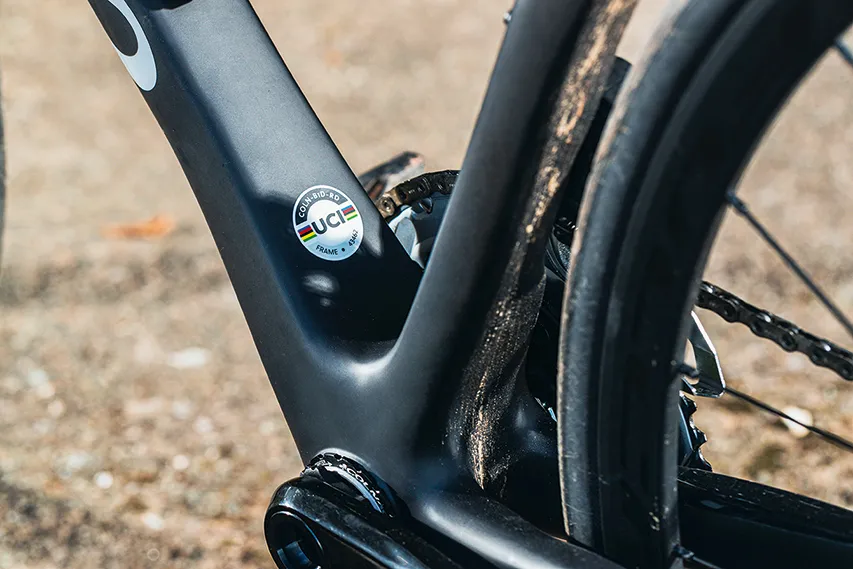
The V3’s frame has aero-optimised tubes, but it’s not an aero road bike.
It’s more in the mould of Cannondale’s SuperSix EVO and Specialized’s Tarmac SL7, in that it’s a machine that aims to combine low weight with aerodynamic touches for a greater all-round experience.
Colnago V3 Rival AXS geometry and dimensions
Colnago’s approach to frame geometry is… traditional. The Italian brand’s designers have stuck, steadfastly, to their idea of what makes a race bike handle well and the V3 is no exception.
Colnago also sizes its bikes differently to other manufacturers (the 56cm test bike equates to a 58cm from most other brands), so it’s well worth looking closely at the geometry and dimensions tables if you’re considering buying one.

You’re best off going by the effective top tube measurement (579mm on the test bike) – just remember that the ‘S’ in Colnago’s sizing denotes a frame with a sloping top tube rather than a horizontal one.
The result of the traditional geometry is a bike that delivers a very different ride to something like the Specialized Aethos.
The Aethos is all about flickable, fast handling. Colnago’s V3, by contrast, offers a more considered ride.
The V3 has the familiar low-slung and fast riding position that’s a key feature of the Colnago experience, but the handling majors on stability.
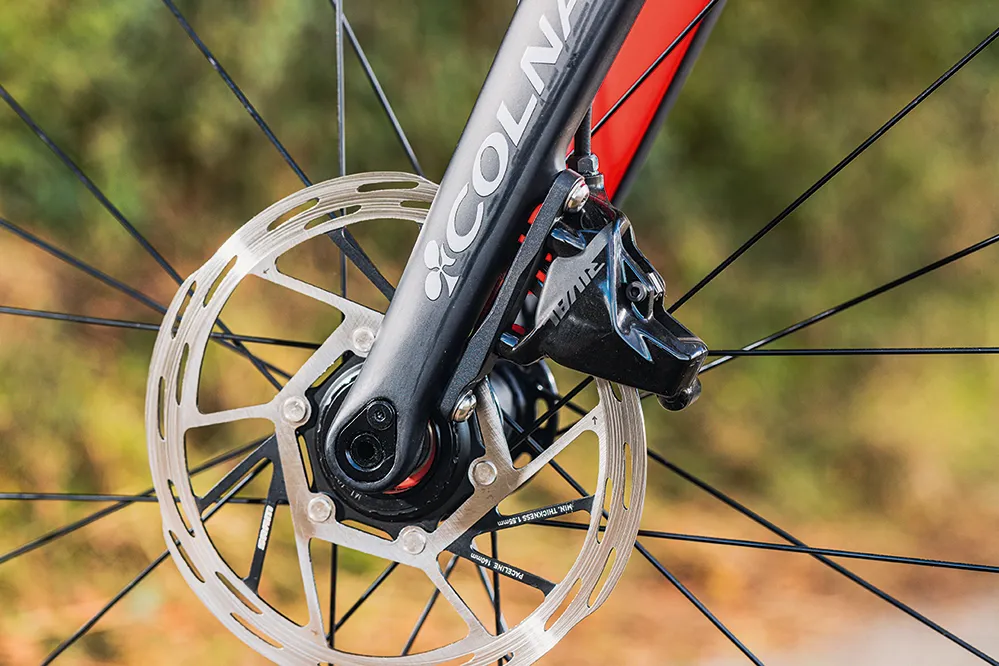
It gave me the confidence to push for greater speeds than I usually would, even when the weather was far from ideal and while running slender 25mm tyres on narrow rims.
The key to the V3’s handling is the parallel, 73-degree head and seat tube angles, which are paired with a 586mm stack that’s low and sporty. The 400mm reach is long and further accentuated by the test bike coming with a 120mm Deda Zero2 stem.
Colnago’s fork offset has been locked at 43mm for years, and combines with the head angle and 25mm tyres to give a trail figure of 59mm, a little longer and less sporty than that of the Aethos.
Colnago has done a decent job when it comes to the build of the V3, with its own carbon-fibre HB01 wing bar being a particular highlight.
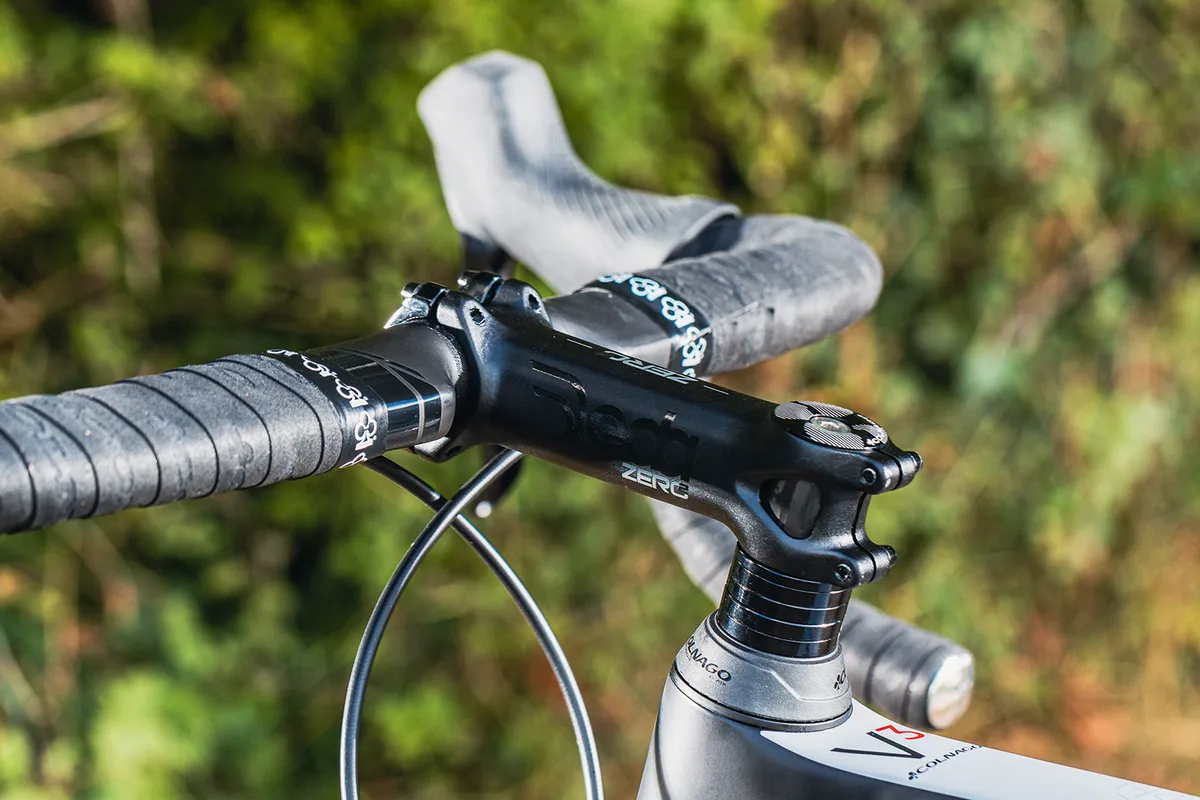
The shape of the tops is superb, with the Kamm tail-like, flat-back section offering a small aero benefit when you’re riding on the drops, while doubling up as a great handhold when you’re upright and settling into a long climb.
The smartly shaped, semi-compact drops are great handholds too, but wherever you decide to place your hands, the carbon bar all but clears road buzz and vibrations when you’re riding over Britain’s many less than perfect road surfaces.
It’s carbon again for the V3’s dedicated aero seatpost, which rises up to a micro-adjust seat clamp with a 20mm offset, so there’s plenty of scope to adjust the reach.
Colnago V3 Rival AXS saddle specifications
Fizik’s Antares saddle isn’t seen that much these days, as most brands now spec shorter, ‘snub-nosed’ saddles.
Returning to the comparatively lengthy Antares, after riding short saddles for the last few years, reminded me of why the Antares was one of my favourites, and I don’t know many people who don’t get on with it.
It’s a smart saddle choice from Colnago and a component that’s not always so well considered on many complete bikes.

Colnago has nailed the V3’s contact points without any obvious cost-cutting or comfort-compromising concessions.
They’re a great match for the frameset and SRAM’s wireless Rival eTap AXS groupset, which is just as competent here as it is on the Specialized.
Colnago has opted for a tighter 10-30 cassette, which delivers an excellent range of gears with single-tooth jumps from the 10- to 15-tooth sprockets.
The range is most similar to that of an 11-32 cassette on a standard 11-speed setup, but that would come with bigger jumps between gears.
The gearing worked smoothly, shifting was accurate and I never found myself wanting for extra sprockets at either end of the cassette.
Colnago V3 Rival AXS wheels and tyres
But, just as with the Aethos Comp, there is a chink in the V3’s armour and, once again, it’s the wheels.
There’s nothing wrong with either the Fulcrum Racing 900DB wheels or the Continental Ultra Sport 25 tyres, and I’d be happy with them on a bike costing around £2,000 or £2,500. But at this price they’re less than I’d have hoped for.

The Fulcrum wheels weigh around 1,950g per pair and contribute a lot to the overall weight of the Colnago, even though, at 8.45kg, it’s hardly a heavyweight.
The wheels are two-way fit, so you could upgrade to tubeless tyres should you want to, and their 19mm internal width is ideal for 28mm tyres.
The V3’s frame and fork has clearance for 30mm tyres, but such was the smoothness of the V3’s ride that I rarely felt any desire to move up from 25mm rubber.
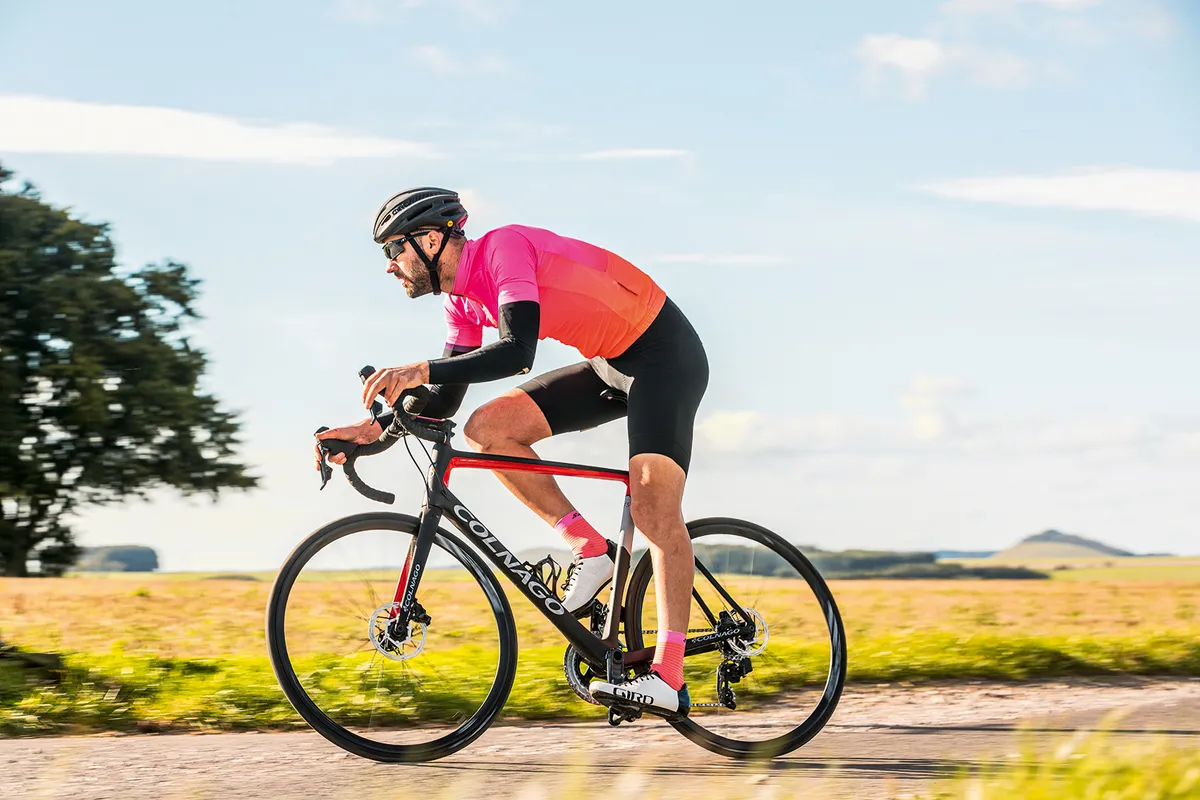
The Fulcrum wheels are wrapped in Continental Ultra Sport tyres – very good mid-range rubber and, at 260g per tyre, only 52g heavier than Continental’s top-end GP5000 model. They grip well and are tough enough for winter riding.
But when it comes to fast, dry rides, the Ultra Sports don’t have quite the same spark.
A wheel and tyre upgrade could easily drop half a kilo from the V3’s weight, adding real sparkle to what is an already impressive ride.
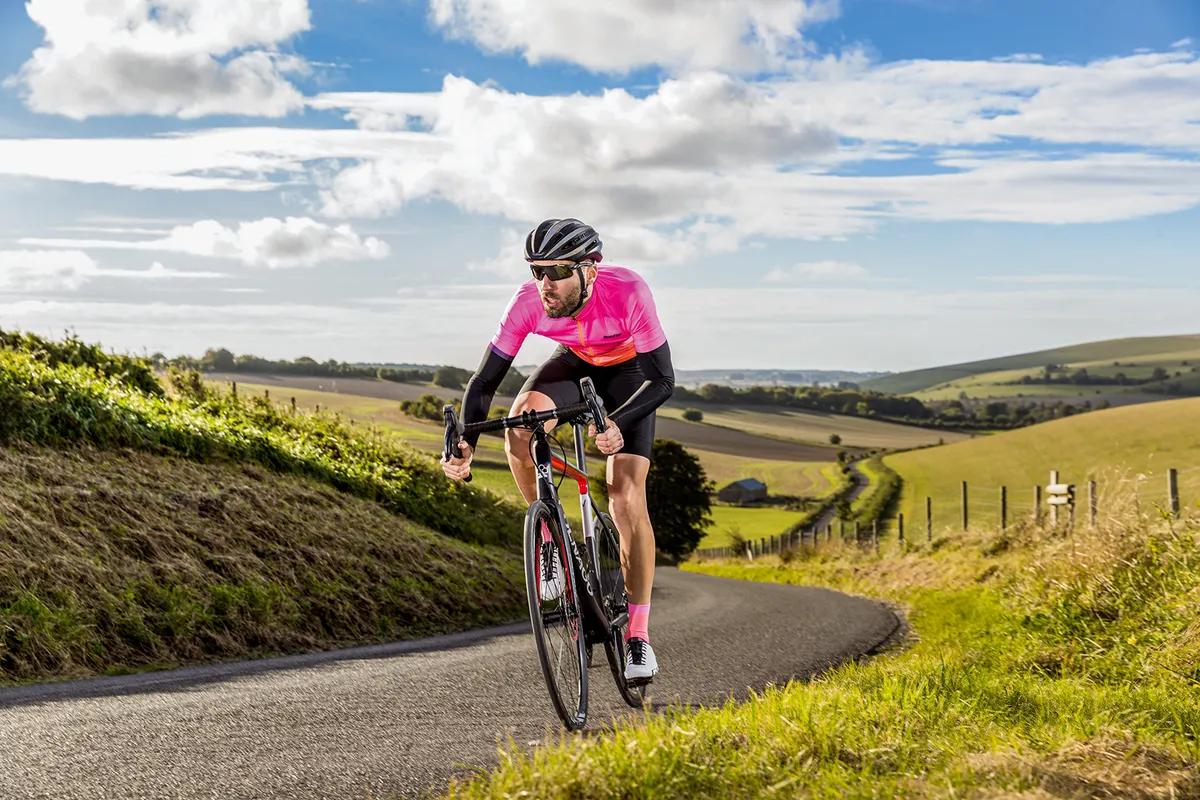
Colnago V3 Rival AXS ride impressions
I haven’t had as much experience on the V3Rs as I’ve had riding the S-Works Aethos, and was limited to a few European demo days before the pandemic restrictions, but the relationship between the ‘standard’ bikes and their high-end siblings is similar.
The V3Rs has a tauter, firmer and lighter ride than the ‘standard’ V3, and, just like the Aethos/Aethos Comp comparison, I’m not convinced the vastly more expensive V3Rs would offer as much to the average rider as the more affordable V3 with its more supple ride.
Colnago V3 Rival AXS geometry
| | 42s | 45s | 48s | 50s | 52s | 54s | 56s | 58s |
|---|---|---|---|---|---|---|---|---|
| Seat angle (degrees) | 75.5 | 75 | 74.5 | 74 | 73.57 | 73.1 | 73 | 73 |
| Head angle (degrees) | 70.6 | 71 | 71.5 | 71.6 | 71.9 | 72.5 | 72.9 | 73.1 |
| Rear centre (mm) | 408 | 408 | 408 | 410 | 410 | 414 | 414 | 414 |
| Front centre (mm) | 580 | 580 | 581 | 588 | 593 | 599 | 607 | 619 |
| Top tube (mm) | 501 | 514 | 526 | 537 | 549 | 565 | 579 | 593 |
| Head tube (mm) | 113 | 114 | 117 | 132 | 151 | 168 | 175 | 193 |
| Bottom bracket drop (mm) | 67 | 70 | 71 | 72 | 72 | 72 | 72 | 72 |
| Stack (mm) | 514 | 520 | 525 | 542 | 560 | 578 | 586 | 604 |
| Reach (mm) | 368 | 375 | 380 | 382 | 384 | 390 | 400 | 408 |
How we tested
One bike won the Tour, the other is record-breaking, but which of the more ‘affordable’ models of these remarkable bikes can live up to their hyper-bike siblings’ status and ride qualities? We put them to the test on our local roads to find out.
Also on test
Product
| Brand | colnago |
| Price | 4500.00 GBP |
| Weight | 8.4500, KILOGRAM (56s) - |
Features
| Fork | V3 Carbon |
| br_stem | Deda Zero2 |
| br_frame | V3 Carbon |
| Tyres | Continental Ultra Sport 25mm |
| br_brakes | SRAM Rival hydraulic disc |
| br_cranks | 48/35 |
| br_saddle | Fizik Antares R5 |
| br_wheels | Fulcrum Racing 900 DB |
| br_cassette | 10-30 |
| br_seatpost | Colnago carbon V3 |
| br_handlebar | Colnago HB01 carbon wing bar |
| br_availableSizes | 42, 45, 48, 50, 52, 54, 56, 58s |
| br_rearDerailleur | SRAM Rival eTap AXS |
| br_frontDerailleur | SRAM Rival eTap AXS |
| Features | Extras: Two Colnago carbon bottle cages |
